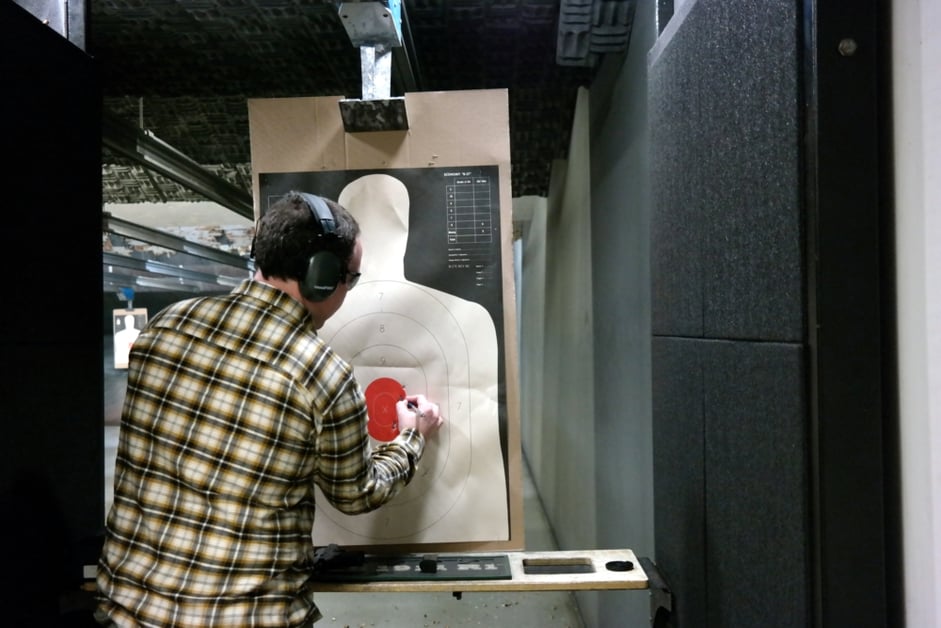In a previous article, we went over different types of targets to give you a better idea of what can help you in your training. Now we want to discuss distance. This is a big question for concealed carriers because we know that in the heat of the moment, there’s going to be quite a bit more shakiness than one would normally experience in routine practice.
For this, we’re going to borrow a bit from the International Practice Shooting Confederation.
NOTE: The IPSC is a private organization dedicated to fostering a competitive and fun experience for firearms enthusiasts. Their courses are designed for sport with influence from real life. If you’re able and have the inclination check them out and see if it’s something you feel would benefit your everyday carry strategy.
While the IPSC offers courses of fire for beginners and experts, we’ve noticed that a majority of their distances are between 5-20 meters (~5½ to 22 yards). The closer a competitive shooter gets, the more nuance there usually is in choosing and switching targets.
This captures an important aspect for concealed carry training. We should be proficient at handling targets within the 5 meter range (~16.4 feet).
This ties in multiple realistic expectations.
As concealed carriers, we shoot to neutralize a threat that we believe intends harm upon us or others. In many of the defensive gun use scenarios we’ve covered at Concealed Nation, we’ve noticed a general scenario erupt in convenience stores, gas stations, parking lots, and on private property.
There are a lot of close quarters fights.
Criminals Depend Upon Little To No Early Warning
Concealed carriers often have little advance warning of a threat and have to react extremely fast. This is because the armed criminal doesn’t know the concealed carrier is armed and wants to maximize his chances of being effective.
The closer the bad guy is, the better the chance he can use his firearm or weapon.
Think about it from an average unarmed Joe perspective.
If an armed criminal approaching someone on the street and takes his gun out at 60 feet, he’s just telegraphed his intentions to everyone (including witnesses and police). This would normally result in people bugging out and fleeing the scene. It would also leave him exposed to incoming fire from people responding to him brandishing a firearm or weapon. And let’s not forget — people have cell phones and they will be calling 911 the second they see someone intending violence.
It’s completely ineffective. We can’t rule out a criminal wouldn’t do that because — as we’ve also seen with a number of stories we’ve covered — criminals aren’t always the brightest ones in the bunch.
So, in any case we’re dealing with a criminal who’s intent is to profit from harming another, i.e. robbing someone at gun point or robbing a cash register, he’s probably not going to show his hand until he’s within his own striking range.
For criminals who’s intent is much more nefarious — like opening fire indiscriminately on multiple people — close range is less necessary but we believe you’ll still find that the attackers will always move to within the range they believe is necessary to exact the type of damage they’re looking to deal.
Even with mass shooting events such as the Marine Corps Recruiting Station shooting in Chattanooga and the San Bernardino shooting, we see the attacker move into his ideal range.
That’s unfortunately the ranges we need to be focused on as concealed carriers.
Concealed Carry Is Defensive
We have to wait for attackers to show intent.
Because concealed carry is by definition a defensive measure, we’re unfortunately left in the unenviable position of being dependent upon our attackers to show their hands.
This is why practicing within the >5 to 20 meter range is critical.
In the heat of the moment, do you feel confident putting a bullet on target at 60 feet with your concealed carry pistol?
Chances are very few people are. And even fewer actually have the skills and discipline to pull it off successfully.
No, in most incidents, we see concealed carriers getting their successful hits in at less than 20 feet. This is convenience store range. This is close quarters.
The second the bad guy moves into the 40-60 feet range, we see a lot of missing.
Missing is bad for concealed carriers. Because, unlike criminals, we’re held accountable for every bullet that leaves the chamber. If we strike someone else’s property or — God forbid — a bystander… We’re legally liable for that.
Having reliable, solid shot groups at 5, 10, 15, 25, and 35 feet will go a long way to preparing you for the reality of putting rounds on target in a concealed carry defensive gun situation.














